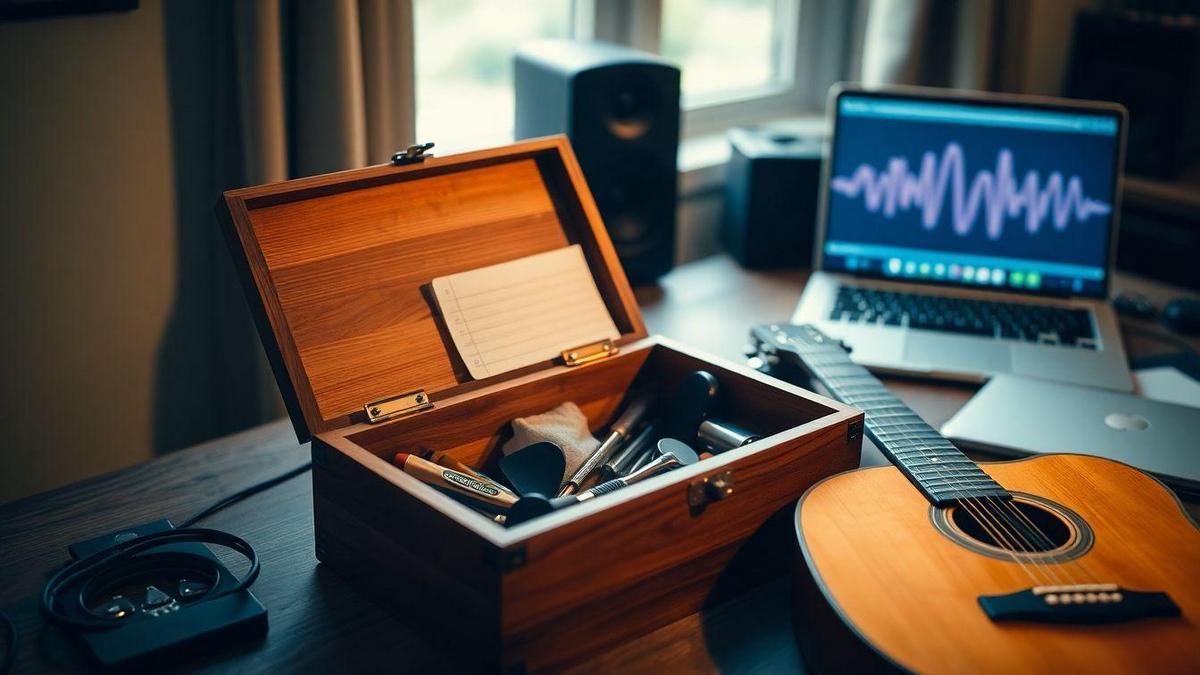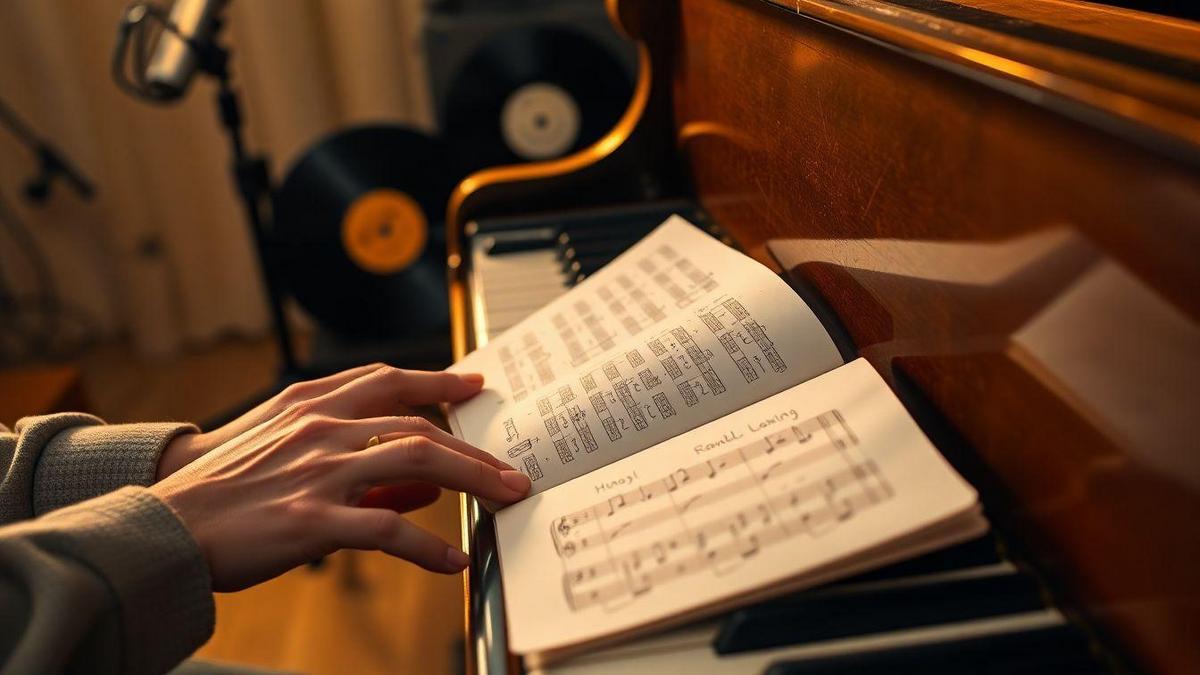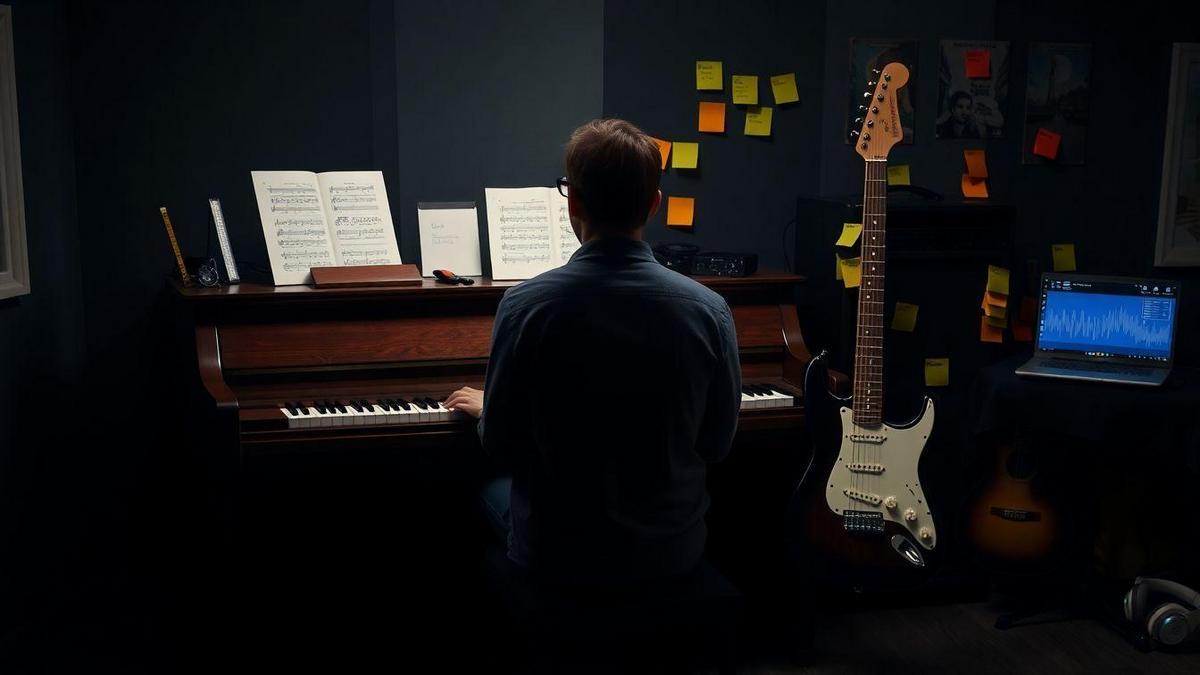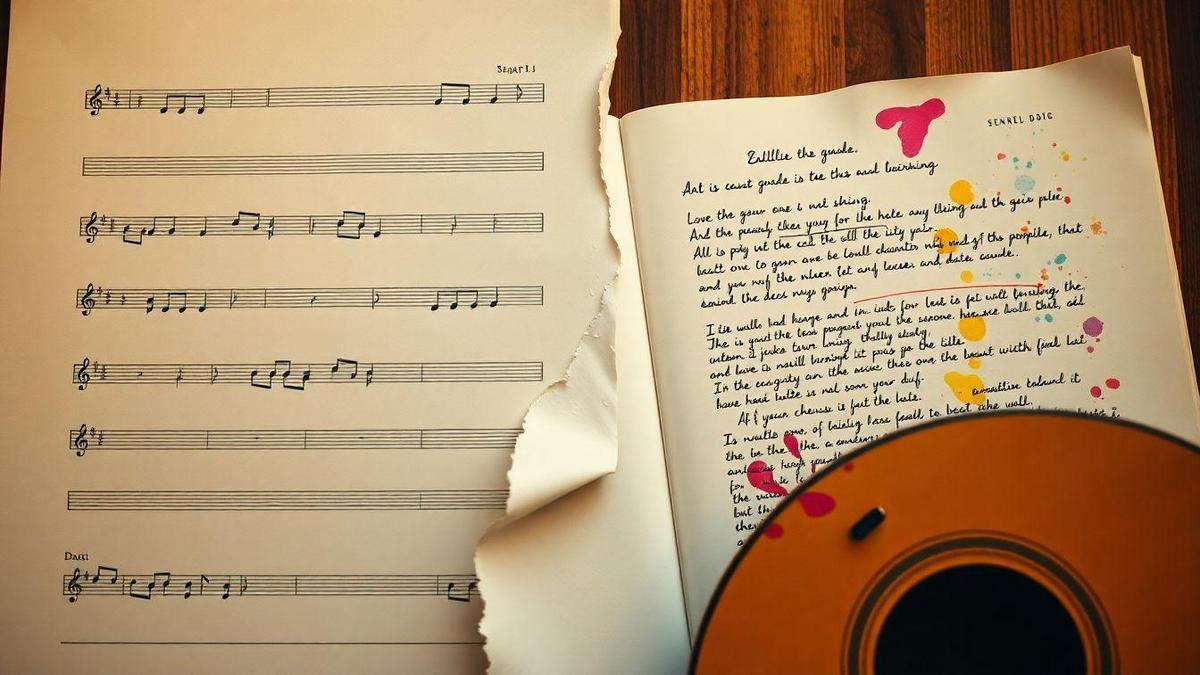Does theory help or hold you back when creating music?
I treat music theory as a toolbox: useful shortcuts and labels for ideas my ear already finds. Does theory help or hold you back when creating music? My answer: it helps when used as a guide, not a cage. Below I show practical ways I use theory—chord maps, scales, harmony, rhythm, and arrangement—plus exercises, tests, and a simple measurement system so you can tell whether theory speeds your writing or stalls it.

Key takeaway
- Use theory to help songs, not to trap them.
- Learn simple rules to open new ideas.
- Trust your ear when theory feels wrong — build ear skills with resources on playing by ear.
- Practice targeted drills to fix weak spots.
- Mix rules with feeling to make songs real.
If the idea of theory feels intimidating, the guide on why music theory isn’t as scary as it seems is a good mindset reset.
How I use theory as a practical toolbox
Theory gives me shortcuts and labels—so I can write faster and clearer. I play first, then name what worked. If theory restricts flow, I step back and change tactics.
I link theory and songwriting with simple chord maps
A chord map is a tiny visual cheat-sheet for quick progressions.
- Start small: pick a key and list 3–5 compatible chords.
- Label them: numbers (I, IV, V, vi) or names (C, F, G, Am).
- Make routes: note 2–4 chord loops (I → vi → IV → V).
- Tag roles: home, tension, release.
- Test short loops (2–4 bars), record what feels alive.
If you want the basics of what chords are and why they matter, see the primer on what chords are and why they matter, and for reading chord shapes and lead sheets try the quick guide to reading chords and sheet music. You can also consult the basic concepts of chords and harmony for a concise reference on chord types, triads, and inversions.
Example: I–vi–IV–V is a go-to—change rhythm, voicing, or instrument and it becomes new.
I learn scales and harmony to speed up writing
Scales and functional harmony let me pick melodies and progressions without guessing.
- Learn one scale at a time: major → minor → pentatonic.
- Match scales to chords (Am → A minor or A minor pentatonic).
- Use modes as flavors (Dorian for jazzy, Mixolydian for groove).
- Think function: tonic (stable), dominant (push), subdominant (middle color).
A clear walk-through of scale basics helps: scales explained in plain English, and for forming smoother harmonic choices, see a beginner’s guide to harmony. For a musician-focused primer on modes and harmonic function, check this practical guide to scales and harmony.
Keep a small list of scale-to-chord pairs as a cheat sheet.
Quick exercises to build practical theory skills
Short, focused practice beats long, sleepy sessions.
- Chord map loop (10 min): pick a progression, try 3 rhythms, record the best take.
- Scale-to-melody (8 min): improvise a 4-bar melody over one chord — if improvisation feels hard, the improvisation primer is a practical start.
- Reharmonize (15 min): swap one chord at a time in a simple tune, note mood shifts.
- Sing roots (5 min): sing each chord root before you play it.
- Loop & vary (10 min): change voicing, bass note, rhythm, or melody each pass.
Use a timer, keep a notebook, and record imperfect phone takes—often the best hooks hide there. The Royal Conservatory also collects focused exercises to build theory skills you can adapt for loops, improvisation, and timed tasks.

When theory holds me back — and how I avoid it
Theory becomes harmful when it turns songwriting into an exercise in correctness.
Signs theory is stifling:
- Parts sound safe and predictable.
- You overthink instead of play.
- You edit mid-idea to check rules.
- Songs feel like proofs, not moves.
Countermeasures:
- Slow down and trust feeling.
- Time-box writing sessions.
- Set breakable rules (see next section).
- Run small tests to see if theory is blocking color or momentum — for creative blocks and ways through them, check how to break creative blocks.
Rules you can break
I use simple, flexible constraints that are meant to be bent.
- Limit the palette (one scale or three chords for 10 minutes). Break: swap in an out‑of‑scale chord.
- Time-box (15 minutes to a full idea). Break: extend if it breathes.
- One focus per take (melody OR rhythm OR lyrics). Break: combine if a spark appears.
- No theory checks first—record raw ideas, analyze later.
Small tests to prove whether theory helps or hurts
Treat each test like a mini-lab.
- Play 2 minutes without thinking of keys/scales; record. If it feels alive, theory was blocking you.
- Write a 5-minute melody in one scale, then swap one note to a chromatic tone. If it sparks, theory limited color.
- Use 3 chords for a chorus; add one surprise chord in bar 3—did it improve the hook?
- Improvise with your non-dominant hand/instrument for 3 minutes—mistakes often lead to fresh ideas.
If you want straightforward melody starters that reduce overthinking, look at writing your first melody without overthinking.
Balancing theory vs intuition: my workflow
I capture feeling first, then use theory to refine.
- Capture: record a raw idea (speed beats perfection).
- Pinpoint: find the key and main chord movement.
- Trust test: play loud and simple—if it still moves you, proceed.
- Small edits: swap one chord, alter one note, change rhythm—use theory as a tool.
- Arrange: add bass, pad, harmony to serve the feeling.
- Field test: play to people, note what lands.
- Final polish: tidy voice-leading, keep rough bits that give character.

How I use theory to write singable melodies
Does theory help or hold you back when creating music? For melodies, theory helps when used lightly—choose scales and intervals that match mood and voice range.
- Bright: major or pentatonic.
- Sad/introspective: natural minor or Dorian.
- Folk/pop hooks: pentatonic is forgiving.
- Add spice: raised fourth or flat second for tension.
Melody drills:
- Three-note motif: repeat with different rhythms.
- Step-and-leap contrast: motion then a single dramatic leap.
- Call-and-response: find the catchiest pairing.
- Limit notes: write a verse with 4 notes—force rhythm and lyrics to vary.
For interval choices that make melodies singable, the guide to musical intervals with real examples is helpful. Also consider the emotional choices for each note with how to add emotion to every note.
Record phone memos and sing before writing notes—ear first, labels second.

Making chord progressions with theory without losing soul
Learn classic progressions, then bend them.
- Memorize shapes like I–V–vi–IV, ii–V–I, vi–IV–I–V.
- Practice with different voicings and bass movements.
- Add color chords sparingly: add9, 7ths, sus2/sus4, modal interchange (bVI/bVII), secondary dominants (V/V).
- Rule of thumb: change one note at a time to keep cohesion.
Quick chord recipes (in C):
- Pop heart: C–G–Am–F → Cadd9 in chorus.
- Soul lift: Am–F–C–G → Fmaj7 to soften.
- Modal color: C–Bb–F–C → Bb for a retro feel.
- Bass walk: C–C/B–Am–G → chromatic bass for motion.
If you want a refresher on chord fundamentals as you experiment, see what chords are and why they matter.

Rhythm and groove: theory that moves the song
Rhythm is the heartbeat. Start with a pulse, then layer melody and words. For authoritative exercises on meter and feel, check resources that focus on practice and groove like the foundations of rhythm and groove practice.
- Pick a meter to match mood: 4/4 (steady), 3/4 (waltz), 6/8 (rolling).
- Use syncopation to add surprise; drop expected beats to create space.
- Simplify beats so singers and players can groove easily—strong downbeat one or two accents.
- Practice patterns with a metronome and sing over them to check vocal space.
Common patterns I use:
- Basic rock (4/4): kick 1 & 3, snare 2 & 4.
- Syncopated pop: off-beat kicks for push.
- 6/8 roll: accents on 1 and 4 for flow.
- Backbeat with space: leave room for lyrics.
If metronome practice gets frustrating, the tips in using a metronome without losing patience make steady practice less of a chore.

Arrangement and production guided by theory
Use harmony and texture to build tension and release.
- Start thin in verses, thicken in choruses, drop for bridges.
- Use suspensions/add9/additions for gentle tension.
- Choose keys so the melody sits comfortably in the singer’s range.
- Check frequency space with EQ and listen in mono.
Arrangement checklist:
- Identify the core idea (melody, hook, groove).
- Set the key by melody range.
- Outline chord map for sections.
- Plan texture per section (thin → thick → thin).
- Assign roles: lead, support, glue (bass/drums).
- Add small harmonic twists (borrowed chords or inversions).
- Test live or with a friend; adjust.

Teaching myself songwriting with focused theory practice
Theory sticks when it ties directly to songs.
Short goals with song ties:
- Learn four chord shapes → write a 16-bar progression using them.
- Master the major scale position → create a chorus melody from it.
- Use a secondary dominant once → add tension to a bridge.
- Finish a 30-second hook → drop the best take into a demo.
Daily practice plan (concise):
- Warm-up (5–10 min).
- Ear training (10–15 min).
- Focused theory drill (15–20 min).
- Apply to a song/demo (20–30 min).
- Review and set tomorrow’s goal (5 min).
For making practice stick and fun, the pieces on making practice fun and overcoming procrastination in practice are full of practical tips. If you’re teaching yourself from scratch, can you learn music on your own? tackles the common questions.
Weekly rotation: chords, melody, harmony color, rhythm, structure, free write, rest.

Does theory help or hold you back when creating music? — How I measure it
I run simple, repeatable tests and track metrics so the answer isn’t just a hunch.
Test format:
- 15 minutes: Test A (follow a theory rule) vs Test B (intuition, no planning).
- Record both raw, pick top 2 ideas from each, score: melody, emotion, playability, fun (1–5).
- Repeat twice a week for a month.
Log what wins:
- Date, source (Rule or Intuition), what it is (riff, progression, melody), time to first usable version, finished? yes/no, how it landed (released/shelved/reused).
- Count wins and look for patterns: do choruses come from rules or gut feeling? Do rules help finish songs faster?
Metrics I track:
- Finish Rate = finished ÷ total.
- Time-to-First-Use = average minutes to a usable idea.
- Emotional Hit = self-score 1–5.
- Reuse Rate = how often parts get reused.
- Player Friendliness = self-score 1–5.
If rule-based ideas finish faster but score lower on emotion, loosen the rules. If intuition yields emotion but few finishes, add one simple rule (chord map or rhythmic anchor) to help complete the idea. For understanding why certain moments land emotionally, read about what makes songs give us goosebumps and the link between music and personal memories. For science-based background on emotional responses to music, see this piece on how music evokes emotion and chills.

Conclusion
Does theory help or hold you back when creating music? Theory helps when it’s a toolbox: pick useful tools (chord maps, scales, harmony tricks), play first, name later. Set small, breakable rules and run quick tests. Time-box sessions, record raw ideas, and score them on emotion, melody, and finish rate. If theory speeds you up, keep it. If it boxes you in, loosen it. Trust your ear above the book, but use theory to polish what your ear already finds true.
For more practical tips and examples, visit ClickNeutro.
